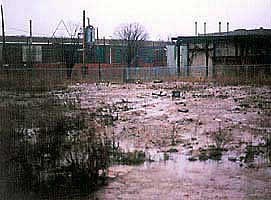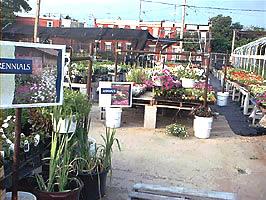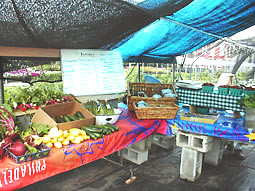
Comments
by
Mary Seton Conroy
Founder
Greensgrow Farm
This article originally
appeared in The Philadelphia Inquirer, August 1, 1999,
“Community Voices” section.
A letter from my father: "Your mother tells me you are thinking of becoming an inner-city farmer. In the 60s and 70s, many people ran off to Vermont and New Hampshire to live off the land and sell produce to the people who can't tell the difference between a homegrown tomato and a 28-ounce can of Progresso. Most of these kooks are not working in brokerage houses. Let Archer Daniels Midland take care of supplying food for the masses. Your ancestors came to this country because they hated farming. They became politicians, doctors, dentists, gamblers, and inventors to avoid the earth."
I think my father knew I'd made up my mind and no amount of protestations would keep me from it.
My partner, Tom Sereduk, and I are building an inner-city farm. We're in the middle of our second year growing produce on a former galvanized steel plant in Kensington. We hope to develop a blueprint of technologies, crops, systems, designs, and schedules for building small, for-profit farms that use vacant land and create jobs in decimated neighborhoods.
Philadelphia has more than 1,000 acres of vacant land. Much of it is postindustrial wasteland—abandoned by companies that left behind buildings, contamination, and rubble. There are small parcels and vast tracks—dumping grounds, urban eyesores, reminders, that no one cares. As this land rots, farmland surrounding Philadelphia is turned into golf courses, strip and megamalls, sprawling office complexes and planned communities with six-bathroom houses. Brownfields vs. greenfields.
As the farms disappear, our food source moves father away and, with each mile produce is grown to be shipped and sold, it becomes more like the carton it is shipped in—sturdy, resilient, and cardboard-tasting.
Over dinner one night, while I bit into a midsummer tomato as hard as a rock, Tom and I wondered why at least the restaurant demand for local produce couldn't be met by the city land available for growing. OK, it isn't pristine, but couldn't the big issues of ground contamination, buried rubble, neighbors, and small parcels be overridden? And weren't we the two to do it?
Tom was a working chef and former plant biologist who wanted to be neither. I was a former chef with a handful of useless degrees, searching for ways to avoid a career path. Somehow we decided that between us we could design, configure, and build a farm, then seed, grow, pick, pack, sell, distribute, market, and deliver our product—a specialty lettuce mix. True, we weren't engineers or carpenters of plumbers, and neither of us had ever actually designed or built anything. True, we only had half a toolbox between us (including a hammer head but no handle). True, neither of us liked detail work (like bookkeeping). True, neither of us had any sales experience. So what? We had an idea. We just needed land and money.
Through the New Kensington Community Development Corporation and John Kromer at the Office of Housing and Community Development, we found land: 100 bucks a month for three-fourths of an acre recently cleaned up by the DPA; no water, electric, or sewage. The Ben Franklin Technology Center, we heard, lent money for "innovative uses of existing technologies."
"Hello, Ben, it's Mary Seton and Tom. Have we got an idea for you."
While we practiced farming in New Jersey, we talked to every person we could think of; and every variation on the urban agriculture theme was plugged into an Internet search until we had enough information to get started.
Tom and I designed a hydroponic (water-based) system, a giant aboveground plumbing apparatus that was water-and-energy efficient. Because it was built above ground, it didn't matter what was in the soil. It was, we thought, the answer to inner-city growing. The neighbors thought otherwise.
To quell the rumors, we held an open-lot meeting. Fifty people came.
We told them our plans, showed them a model, and made some promises:
We would operate in full view, we would always answer questions, we would
test our crops (once a month, we send plant material to Penn State's
agriculture analysis lab to test for airborne pollutants), and we would
keep our block clean. The neighbors viewed us skeptically, to say the
least.
We started from nothing on March 17. By some miracle, we sold our first
cases of lettuce on June 1. By July, we were still way behind in building.
We constantly ran into plumbing problems; production was off; seedling
survival was low. What kept us going was that we sold out of product—100
cases a week loaded into Tom's old Ford Ranger. Weaver's Way bought;
Metropolitan Bakery started carrying us. Chefs from restaurants where
we couldn't afford to eat were calling.
The neighbors started to come around. One of them, Kevin, told people to mind their own business when they asked about our project. Theresa talked to the mother of some kids who tossed rocks over the fence (we never saw those kids again). Al brought us sodas and jokes he heard on the bus to Atlantic City. Chino from the car-detailing place lent me tools and watched in bemused benevolence. When I went to pick up beer at a local tavern, the guys called out, "Hey, it's the cabbage lady." I could hear my dad's heart start to fibrillate.
Through the summer, Tom and I kept up appearances, but, as in a marriage with a secret, we were struggling. By August we were both ready to quit. We were mentally and physically exhausted. We were barely speaking. We had no money. We were still trying to fix leaks, find ways to automate the system, deal with pests (the bug kind—our product is pesticide free), find time for meetings and sales and answer the constant onslaught of questions from every person who saw our operation for the first time. ("What the hell is that thing?")
Seven days a week we came to work at 7 a.m., and some nights we were packing cases at 9. We were sunburned, filthy and working out of a garage with half a roof and a door that kept getting jammed. On a broiling August afternoon, while Tom was off at his second job trying to make rent money, I sat in a mud puddle next to a broken pump and cried. My father's letter echoed in my head. What exactly did I have to do to become a broker?
Fall came. We had finally finished building the system. With shorter days, the plants slowed down. We slowed down. In the last few days, we leisurely ate our lunch on the lot, soaking up the last of the sun. After we delivered the last cases of lettuce, we drove away, wondering if we'd be back. Tom went back to cooking. I bought lettuce at the store for the first time in sixth months. It had no flavor. I went to the office in my basement, thinking about what Tom and I had done wrong, what we had done right.
Chefs called and asked when we'd be back. I went from saying, "I don't know" to "In the spring." Tom joined me in the basement. We eyed each other, weighing whether we were ready to commit to spending the next 10 months pushing the Sisyphean rock around Kensington. Neither of us had kids or families to support, but we couldn't face another year of working second jobs just to support the basics. We needed money; we needed help. Even if we got both, we knew that it would be another very hard year. We eyed each other again. We started seed—just in case (a toe in the water). We went back to Cumberland Street and took the lock off the gate (a leg in).
Over the winter, I had written a number of grant proposals. I didn't know a grant proposal from a marriage proposal, but I sent them in anyway. People who knew about such things tried not to laugh. I told Tom he had to quit his job. He did. The next day, the first grant came through.
A couple of local foundations decided to support us. We borrowed equipment and begged materials. We built a nursery and rented a trailer (I was tired of running to St. Anne's Senior Center to use the bathroom). We added tomatoes and herbs in a whole new system and built flower beds. When the neighbors went by with friends, we heard, "Oh that's a hydroponic farm." We hired three women from the neighborhood to work with us, single moms who rode their bikes to the farm and first thought the lettuce would look like heads of iceberg when it "grew up."
Halfway through our second season, Tom and I are once again sunburned, exhausted and filthy. The system still leaks. Tom has to seed 20,000 new plants a week (I'm older and have convinced him that it will ruin my eyesight if I have to do it). Kelly Simon still can't tell one lettuce from another; Indora Johnson has taken over my collection of hats, and Elaine Williams can regularly be heard chiding the others when they don't toss a proper red-to-green mixture on packing days. They all claim to hate lettuce and can't believe that Tom and I eat it for lunch every day.
In one of the hottest summers in memory, we still manage to pump out 130 cases a week to the kitchens at Fork, London, Pasion, Fega Grill, Opus 251, and others. Chefs meet their grower face to face; they tell me what they'd like, what hey don't want, how they're overworked and underpaid, and that it's hot out. Sounds familiar.
Tom and I know that the feasibility of urban agriculture won't be determined by our project alone. A farmer friend told us that you never want to be first at anything; you have all the problems and the second guy gets all the glory … and money (ask Bill Gates). Among the things we have learned, though, are that the savings on transportation and land costs from city growing are offset by higher wage taxes, parking tickets, smaller volume and way higher auto-insurance rates; that L&I has no provisions for agriculture; that too many chefs don't know where produce comes from; that farm bugs can find their way into the city easier than suburbanites; that payroll services aren't equipped to deal with agriculture operations, and that sunscreen (large quantities) is not a tax write-off. We'll manage to pay our bills again this year, but we know that we have to find ways to extend the season, increase the yields, and grow things in different systems. Farms aren't built in a year …or two.
There are many days I'm ready to throw in the towel. The frustration, the workload, the heat, the problems and the paperwork overwhelm me. I have nightmares about forgetting orders and pumps breaking down.
But there are other days.
Days when I turn the corner and see a full city block of bright red lettuces, flowers, and tomatoes where once people left behind car parts and syringes. Days when I see Tom in the nursery having successes with new growing media and hear chefs asking when the tomatoes will be ready, like children wanting to know when the cookies will be done.
Last fall, as we were readying
to close down, my father visited. I showed him around, explained the
mechanics and design concept, told him how
efficient the system was, had him taste all nine varieties we were growing.
He didn't say much. But on a visit home this spring, I overheard him
explaining to my sisters the photo of the farm I'd brought down: "It's
amazing what they've accomplished. Much bigger than I thought. You really
should see it." On days like that, I know why I'm an urban farmer-dreamer.
Thanks, old man.
![]()
![]()
![]()


